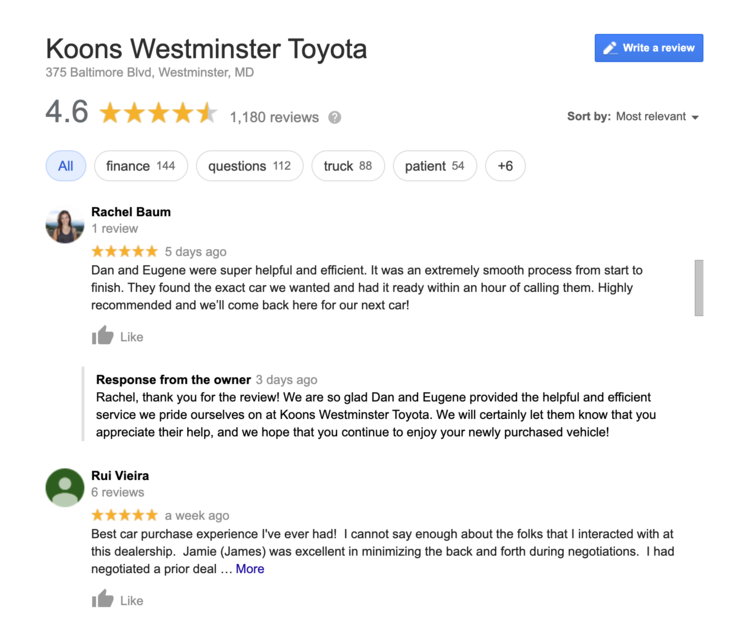-
Products
TechnologyManaged Services
- Resources
- Pricing
- Company
Contrary to popular belief, a managed customer review response service will scale better than an automated solution or AI. Automated products will work well for positive reviews, but fall short on negatives, meaning you will still have to pick up the slack.

Originally posted on March 29th, 2023 and updated on September 18th, 2024.
AI and automation software are transforming reputation management. Smart automation makes review response a breeze —but can you rely on it? Should you trust AI and automation to manage your reviews or stick with the human approach?
In this post, we’ll outline the types of review response solutions available to your business as well as the pros and cons of an AI-driven strategy compared to a managed review response service.

Artificial Intelligence platforms and automated products are on the rise, and so are the possibilities for reputation management.
While there’s no substitute for an actual human being, AI systems can be programmed to deal with many situations, including customer interactions. With the right prompting, AI can take both review content and sentiment into consideration to draft a response, streamlining the review management process. Still, even with the recent technological strides AI has taken, it struggles to deal with negative reviews appropriately. Handling negative feedback effectively takes a lot of social nuance and practice, and when you rely solely on AI, the cracks begin to show.
So how should you work AI into your reputation management strategy? Should you employ automated and AI systems in your business’s reputation management strategy, or should you keep it au naturale?
Now, let’s get into how AI tools do what they do.
You already know how important a review response strategy is for your local business. Google states it will help your search rank. And increased engagement leads to higher ratings and more review volume. If replying to your customer reviews on Google, Facebook, Yelp, and other industry-specific sites will be a part of your marketing strategy this year, great choice.
However, if your business receives more than a couple of reviews per month, you’ll need to develop a strategy to manage them. Responding manually is a lot of work, hard to scale internally, and just not that much fun. Automated services and artificial intelligence programs like ChatGPT can streamline your operations, personalize your customer experience, and improve decision-making, making them an obvious solution
Simply put: No. We don’t recommend a fully automated review response solution.
Contrary to conventional wisdom, Google/Facebook review response automation doesn’t scale as well as a managed online reputation management service because these solutions can’t fully address the nuances of negative reviews.
Additionally, automating responses will lack contextual relevance and branded keywords. Instead, we recommend that you partner with a third-party human-powered agency to manage your replies. Operationally, it will be more efficient, and the superior response quality will give you a competitive edge.
However, it is important to respond to all reviews using some sort of strategy. When starting out, many businesses only respond to negative reviews in an attempt to resolve customer complaints. Google tends to favor reviews that have response activity, and as a result, you may find negative reviews with responses displayed at the top of your GMB. Give your page a look right now and see if this is the case.

You can fix this by responding to all reviews, positive and negative alike, which is made significantly easier by using third-party products.
Perfect segue, let’s get into it.
Before we get into the pros and cons, a note about reply strategy. A quality strategy has two components: respond to every review, and respond with enough nuance and specificity that the responses address the customer’s need, feel human, and project a positive experience to your prospects.
Beyond that, selecting autoresponse software or a managed service depends upon the quality of the product you are attempting to achieve, the level of involvement you would like to have as the internal marketer and your budget.
We’ve broken up the pros into three sections: operational, marketing, and technology capabilities.
In summary, with a hefty amount of upfront work, automated tools will enable your team to set up a response system that will cover roughly 60-75% of the work. If done properly, the responses will be written by a consultant or member of your team initially, and then the software will deploy that content for you.
Efficient
Right off the bat, responding to reviews takes a lot of time. And the more effort you as a marketer put into your reputation management strategy, the more work you will have because an effective strategy creates more review activity, hence more effort.
On average, you’re looking at spending 17% of you or your marketing team’s time on managing reviews. That’s almost a full day every week.
Of course, if your business only gets a few reviews a month, using the response tool built into your GMB account is efficient.
If, on the other hand, your business is receiving over 20 reviews a month, automated tools will save you a lot of time and effort. The efficiency gains are more significant if you manage multiple rooftops, and even more so if your business gets reviews on multiple review websites.
Automating via software solutions is easy to scale. Once you establish response rules, an increase in monthly review volume will have a limited impact on your time.
Patterns for Improvement
Artificial intelligence (AI) can gather and analyze sentiment data from customer reviews and feedback, providing actionable insights to guide better decisions and forecast trends.Cost-Effective
Although not free, it is always cheaper to work with a third-party software or services provider rather than hiring an internal team. Additionally, a third-party solution will eliminate potential problems associated with turnover, so they are especially valuable if you work in a high-turnover industry.
Security
Some automated products have built-in spam or slander detection features. For example, filters that report reviews that link to a competitor or unrelated content. With this tool, you can quickly recognize, address, and mitigate spam events that might pose a threat to your company’s reputation.
100% Response Rate
This is a big one.
A higher response rate than your competitors will gain you a search advantage. Anecdotally, you will be perceived as caring just a bit more - hopefully enough to inspire a prospect to give your business a shot.
As mentioned above, Google defaults your review order to the most relevant. Because of this, we recommend that you respond to all reviews, not just negatives. Universal responses will increase the chance that positive experiences will appear at the top of the pile.
With that said, customers read around 10 reviews on average before making a determination, so you have some wiggle room.
Market Awareness
AI can forecast market trends and customer behavior, allowing your business to target the right customers at the right time, with the right content.
AI-powered tools can automate tasks like email marketing, ad placements, and social media management, optimizing campaigns in real-time for better ROI.
Customization
To maximize your SEO benefits, we recommend a tool that enables you to plug keywords such as your business name, products, and city into your responses. This can be achieved simply through custom templates or tools such as MapLabs, which gives you the option to reference a keyword from the review in your response.
For example, you could establish a rule that recognizes when a customer mentions “takeout” in their review and works that word into the response template programmatically.
As a best practice, we recommend minimizing any sort of defensive or overly emotional response to negative reviews. Your prospects are more likely to believe the customer, so it’s better to remain calm and move conversations with unhappy reviewers offline. Autoresponders can help to eliminate overly emotional responses by disconnecting your team from the specific situation at hand.
Take the Quiz:
How good is your review response strategy? Get your score, 0-100. No email required.
Sentiment Analysis
Automated responses can be catered to different review sentiments, so don’t settle for a tool that sends out blanket thank-yous with no customization capabilities. Here is what you want. A specific response or set of responses will be triggered by the type of review. For example: 4-star with commentary, 5-star with no commentary, etc.
You can write the language that goes out to customers in automated response systems. As the marketer, you want to write the response content during setup. That way, the responses are “human,” just deployed by the computer. The tool should be able to autofill the customer’s username programmatically. Ideally, the tool will check for non-traditional usernames (i.e. beachlover1234) and automatically disregard it in the response. Using reviewers’ names will make the responses seem more personal.
Multi-Platform Awareness
AI programs can provide multi-platform monitoring, scanning multiple review sites, social media platforms, and forums to track brand mentions and reviews in real-time, providing a centralized dashboard for easier management.
Whether you employ automated or AI services, these tools enable the response experience to be relatively nuanced—depending upon how much time you put into setup—and extremely informative.
It's Not Human
One thing to keep in mind is that autoresponders work best for positive reviews with limited unique commentary. Generally, they cannot meet the demands of negative reviews. As a result, you will end up doing most of the negative review response work manually.
To achieve high-quality responses with automated software you will need to respond manually to a material amount of customer reviews.
Negative reviews contain a wide variety of topics and commentary, many of which are likely to surprise you. This makes it difficult to map out all potential scenarios within the autoresponder templates. Further, a broad and disconnected response will likely not solve your customer’s problem and will give prospects a poor impression.
To reiterate above, you will likely need to manually respond to all negative feedback. If you are concerned about efficient use of time within your marketing team, an automated product will increase efficiency when compared to responding 100% manually, but a managed service will take more of the work off you or your team's plate.
Managed services sidenote:
For negative reviews, the Widewail team will send you a suggested response for approval, doing most of the work, but we’ve found it is vital to have input from our clients on negative feedback. Our service and others will still require a small amount of input, but comparatively, it will be the most unobtrusive option for your team.
Autoresponders will miss contextual cues occasionally, along with opportunities to add additional personalization or tangential brand keywords.
This is important. Your business will benefit most from a response strategy that provides every customer with a tailored experience. Consumers are world-class bot detectors; they can tell if a response does not quite match the context of the review.
For example, we often see 4 or 5-star reviews that describe an overall positive experience, but end with a note about how the bathroom was not clean. A generic positive response will look a little off because the bathroom issue was not mentioned.
We also commonly see the name of the salesperson mentioned in a review. It happens all the time. When that occurs, we like to include a sentence such as, “We’re so pleased that you had a great experience working with Jenn.” This touch of personalization will set you apart from your competitors.
In local SEO, your review responses are one of the few opportunities you have to insert your own voice into the conversation on an ongoing basis. Responses are a great opportunity to insert branded keywords, products, or anecdotes describing your company’s values or beliefs. These little details are best achieved through a managed solution.
Which scales better?
Contrary to popular belief, we would argue a managed service. With an automated product, you or your team will be on the hook to handle more and more of the challenging negative reviews as volume grows. A managed service assists with every type of review, supporting your team regardless of content or quantity.
Which is easier to implement?
An automated solution will require a significant amount of setup time, primarily to craft automated response sequences. Your team will also need to learn response best practices for manual response and train new staff members of these practices as positions turnover.
Here at Widewail, onboarding/setup takes about 30 minutes, and ongoing management only takes a few minutes a week.
How do they compare when it comes to cost?
Software solutions are generally more affordable, but the price difference is not as dramatic as you may assume. These solutions are also generally packaged with other features into a product suite, raising the out-the-door price.
Regardless of which option you choose, you are making a great decision to pursue a reputation management strategy. Current customers will be happy to hear from your team, and you will enjoy the benefits of more people walking through the door.
Good luck!
Originally posted on March 29th, 2023 and updated on September 18th, 2024.
I’m the Director of Marketing here at Widewail, as well as a husband and new dad outside the office. I'm in Vermont by way of Boston, where I grew the CarGurus YouTube channel from 0 to 100k subscribers. I love the outdoors and hate to be hot, so I’m doing just fine in the arctic Vermont we call home. Fun fact: I met my wife on the shuttle bus at Baltimore airport. Thanks for reading Widewail’s content!
Bite-sized, to-the-point, trend-driven local marketing stories and tactics.
Automated Review Generation
Video Testimonial Generation

Maintain Accurate Listings

Private Surveys
Review Response Managed Services
Social Media Engagement Services
©Widewail 2026.
U3GM Blog Post Comments